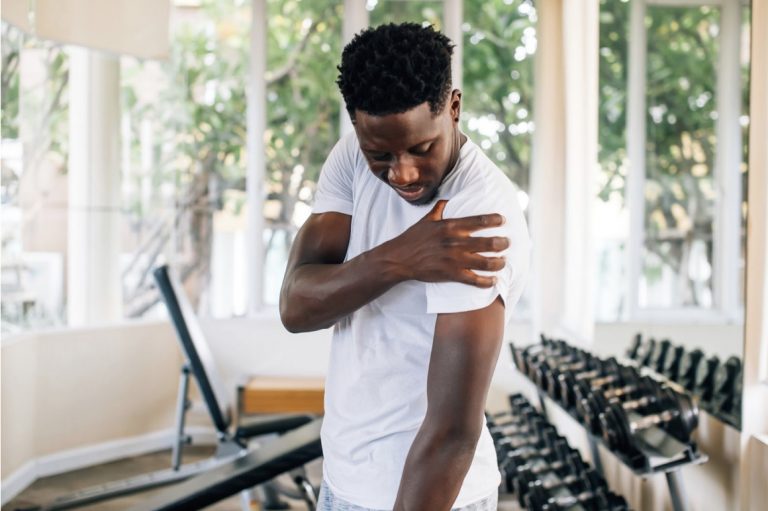A rotator cuff tear is a common shoulder injury that affects approximately two million people a year in the U.S., according to the American Academy of Orthopaedic Surgeons (AAOS). The rotator cuff is a group of muscles and tendons that support the shoulder joint and help you lift and move your arm. A rotator cuff tear occurs when one of the supportive tendons tears away from the arm bone.
Now, hearing that your tendon is torn may cause you to think that you’ll need surgery to repair it. But that’s not necessarily the case. Many rotator cuff tears respond well to non-surgical treatments and don’t require surgery at all.
Keep reading to learn more about when non-surgical versus surgical treatment is recommended for rotator cuff injuries.
An Overview of Rotator Cuff Tears
Rotator cuff tears can be partial or complete. A partial tear occurs when the tendon is damaged but not completely severed from the bone. A complete tear occurs when the tendon separates entirely from the arm bone.
What causes rotator cuff tears? Acute tears are frequently caused by accidents like a car crash, a bad fall, or a sports-related accident. Many tears occur slowly over time due to age, overuse, and progressive wear and tear. Older adults and people who perform repetitive overhead lifting (like construction workers, painters, tennis players, or baseball players) are at higher risk of developing a rotator cuff tear.
Rotator cuff tears cause pain, stiffness, loss of range of motion, and weakness in the affected shoulder. Common symptoms include:
- Pain with lifting the arm or moving the arm away from the body
- Arm and shoulder weakness
- Shoulder pain at night, especially from lying on the affected shoulder
- Popping, clicking, or grinding sounds with shoulder movement
Without treatment, rotator cuff tears will worsen and grow larger over time, which is why it’s important to see your doctor if you have ongoing symptoms. Not everyone experiences pain from a rotator cuff injury, but the majority of people have some degree of weakness and loss of range of motion.
Non-Surgical Treatment Options
The goal of treatment is to reduce pain and restore function in the least invasive way possible. Approximately 80% of people with partial rotator cuff tears respond well to non-surgical methods and regain shoulder strength and movement without surgery, per the AAOS. Your doctor may recommend some or all of the following treatments for your injury:
- Rest and activity modifications. You’ll be encouraged to avoid activities that aggravate your pain and symptoms — like reaching overhead.
- Medications. Pain medications like acetaminophen or NSAIDs (ibuprofen, naproxen) can provide mild to moderate pain relief.
- Physical therapy. Physical therapy is a crucial part of non-surgical treatment. Therapy and targeted exercises will help you regain strength, range of motion and flexibility in the affected shoulder.
- Corticosteroid injection. If the above treatments aren’t effective, your doctor may recommend an injection containing an anesthetic combined with a corticosteroid medication. Cortisone injections temporarily relieve pain and inflammation around the affected shoulder.
The recovery process can be long and slow — some tears take up to a year to improve. Remember to follow your doctor’s instructions for returning to exercise, sports, and other physical activities. Using your injured shoulder too soon and too frequently can cause a rotator cuff tear to worsen.
Surgical Treatment
What if you’ve tried all the treatments listed above and you’re still experiencing pain, stiffness, and loss of shoulder movement? At this point, your doctor may discuss surgical options with you. Common signs that indicate surgery is the next best step include:
- You have a complete rotator cuff tear
- You have a partial tear that doesn’t respond to non-surgical treatment after 6-12 months
- You have a large tear
- You have persistent pain
Additionally, your doctor may recommend surgery if you have a job or play a sport that requires frequent shoulder use.
The most common surgery to repair a rotator cuff tear is arthroscopic surgery. During the procedure, your doctor will make small incisions in your shoulder and insert a tiny camera and surgical tools to reattach the torn tendon to the bone.
After surgery, the healing process will take several months. With the help of physical therapy, many people regain function and strength within four to six months.
Treat Your Shoulder Pain at BEST Health System
BEST provides a single-solution experience for orthopaedic and spine care, pain management, sports medicine, urgent orthopaedic care, and outpatient surgery. Our unique care model integrates all services and treatments our patients need, including imaging, personalized treatment plans, innovative pain management procedures, physical therapy, and orthopaedic and spine surgery.
If you have persistent shoulder pain, don’t wait any longer to see a doctor. Please call us to speak with any of our dedicated facilities and schedule your first appointment with BEST Health System.
